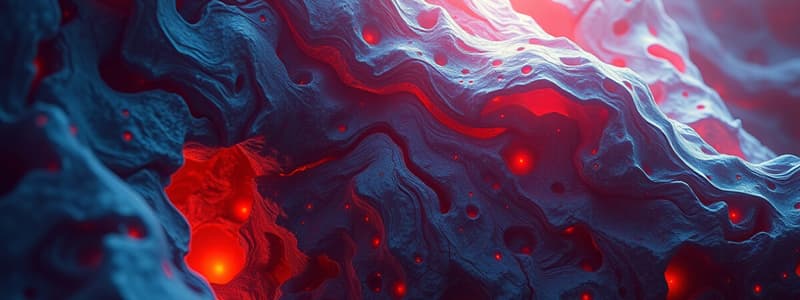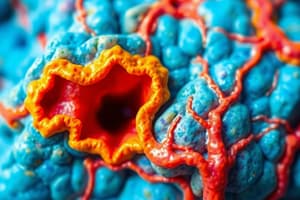Podcast
Questions and Answers
Match the types of muscle tissue with their characteristics:
Match the types of muscle tissue with their characteristics:
Skeletal Muscle = Voluntary control, striated appearance Cardiac Muscle = Involuntary control, intercalated discs Smooth Muscle = Non-striated appearance, spindle-shaped cells All Muscle Tissues = Composed of long fibers
Match the functions of epithelial tissue with their descriptions:
Match the functions of epithelial tissue with their descriptions:
Protection = Acts as a barrier against mechanical injury Absorption = Facilitates the intake of nutrients Secretion = Produces and releases substances like enzymes Excretion = Eliminates waste products from sweat glands
Match the muscle tissue structures with their features:
Match the muscle tissue structures with their features:
Skeletal Muscle Structure = Composed of long, cylindrical fibers Cardiac Muscle Structure = Connected by intercalated discs Smooth Muscle Structure = Non-striated, elongated fibers All Muscle Tissues = Exhibit a single nucleus per cell
Match the epithelial tissue classifications with their characteristics:
Match the epithelial tissue classifications with their characteristics:
Match the interactions between muscle and epithelial tissue with their functions:
Match the interactions between muscle and epithelial tissue with their functions:
Match the features of skeletal muscle with its structure:
Match the features of skeletal muscle with its structure:
Match the characteristics of cardiac muscle with its structure:
Match the characteristics of cardiac muscle with its structure:
Match the functions of epithelial tissues with their examples:
Match the functions of epithelial tissues with their examples:
Flashcards are hidden until you start studying
Study Notes
Types of Muscle Tissue
-
Skeletal Muscle:
- Voluntary control
- Striated appearance
- Multinucleated fibers
- Responsible for body movements
-
Cardiac Muscle:
- Involuntary control
- Striated appearance
- Intercalated discs connect cells
- Found only in the heart
-
Smooth Muscle:
- Involuntary control
- Non-striated appearance
- Spindle-shaped cells
- Found in walls of hollow organs (e.g., intestines, blood vessels)
Functions of Epithelial Tissue
- Protection: Acts as a barrier against mechanical injury, pathogens, and chemical exposure.
- Absorption: Facilitates the intake of nutrients (e.g., in the intestines).
- Secretion: Produces and releases substances (e.g., enzymes, hormones).
- Excretion: Eliminates waste products (e.g., from sweat glands).
- Filtration: Allows selective passage of materials (e.g., in kidneys).
- Sensory Reception: Contains sensory cells for detecting stimuli.
Muscle Tissue Structure
-
Skeletal Muscle Structure:
- Composed of long, cylindrical fibers
- Organized into bundles (fascicles)
- Surrounded by connective tissue (epimysium, perimysium, endomysium)
-
Cardiac Muscle Structure:
- Shorter, branched fibers
- Connected by intercalated discs
- Contains a single nucleus per cell, often centrally located
-
Smooth Muscle Structure:
- Non-striated, elongated fibers
- Cells are tightly packed
- Single nucleus per cell, centrally located
Epithelial Tissue Classifications
-
By Number of Layers:
- Simple Epithelium: Single layer of cells (e.g., simple squamous, cuboidal, columnar)
- Stratified Epithelium: Multiple layers of cells (e.g., stratified squamous, transitional)
-
By Cell Shape:
- Squamous: Flat, scale-like cells
- Cuboidal: Cube-shaped cells
- Columnar: Tall, column-like cells
Interactions Between Muscle and Epithelial Tissue
-
Muscle Movement and Epithelial Function:
- Smooth muscle contractions facilitate the movement of substances across epithelial layers (e.g., digestion).
-
Epithelial Protection:
- Epithelial tissues protect underlying muscle tissues from external damage and pathogens.
-
Nerve Supply:
- Epithelial tissues typically receive nerve supply that influences muscle activity (e.g., reflexes in skeletal muscle).
-
Regenerative Ability:
- Both muscle and epithelial tissues exhibit a capacity for regeneration, crucial for healing and recovery.
Types of Muscle Tissue
-
Skeletal Muscle:
- Linked to voluntary movements, allowing conscious control.
- Features a striated appearance due to the arrangement of muscle fibers.
- Composed of multinucleated fibers, which enhances contractile strength.
- Predominantly responsible for locomotion and posture.
-
Cardiac Muscle:
- Functions involuntarily, primarily orchestrating heart contractions.
- Also striated, reflecting specialized structural organization.
- Intercalated discs are unique junctions that allow for synchronized contraction.
- Exclusively found within the heart, facilitating blood circulation.
-
Smooth Muscle:
- Operates under involuntary control, managing internal processes.
- Exhibits a non-striated appearance, consisting of smooth fiber cells.
- Comprises spindle-shaped cells, enhancing flexibility and function.
- Present in the walls of hollow organs like the intestines and blood vessels.
Functions of Epithelial Tissue
- Protection: Serves as a barrier, safeguarding underlying structures from damage, pathogens, and chemicals.
- Absorption: Essential for nutrient uptake, notably in the digestive tract.
- Secretion: Produces various substances including enzymes and hormones, vital for bodily functions.
- Excretion: Facilitates the removal of waste, such as through sweat glands.
- Filtration: Allows selective passage of materials, particularly in kidney function.
- Sensory Reception: Contains specialized cells for detecting environmental stimuli.
Muscle Tissue Structure
-
Skeletal Muscle Structure:
- Composed of long, cylindrical fibers arranged into bundles called fascicles.
- Bundles are enveloped by connective tissue layers: epimysium (outer), perimysium (surrounding fascicles), endomysium (around individual fibers).
-
Cardiac Muscle Structure:
- Features shorter, branched fibers designed for efficient contracting.
- Interconnected by intercalated discs, promoting coordinated heartbeats.
- Typically, each cell has a single, centrally located nucleus.
-
Smooth Muscle Structure:
- Cells appear elongated and lack striations, contributing to smooth muscle's unique functions.
- Fibers are densely packed with a single, centrally located nucleus in each cell.
Epithelial Tissue Classifications
-
By Number of Layers:
- Simple Epithelium: Consists of a single cell layer; includes types like simple squamous, cuboidal, and columnar.
- Stratified Epithelium: Composed of multiple cell layers; examples include stratified squamous and transitional epithelium.
-
By Cell Shape:
- Squamous: Flat, thin cells that facilitate diffusion and filtration.
- Cuboidal: Cube-shaped cells, often involved in secretion and absorption processes.
- Columnar: Tall, column-like cells, usually specialized for absorption or secretion.
Interactions Between Muscle and Epithelial Tissue
- Muscle Movement and Epithelial Function: Smooth muscle contractions aid in propelling substances through epithelial layers, crucial for processes like digestion.
- Epithelial Protection: Epithelial layers offer crucial protection to underlying muscle tissues from harm and pathogens.
- Nerve Supply: Epithelial tissues often have a nerve supply, which modulates muscle activity, impacting reflexes and movements in skeletal muscle.
- Regenerative Ability: Both muscle and epithelial tissues possess regenerative capabilities, essential for recovery and healing processes.
Studying That Suits You
Use AI to generate personalized quizzes and flashcards to suit your learning preferences.




